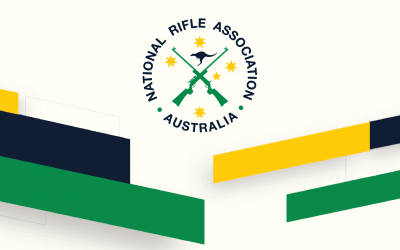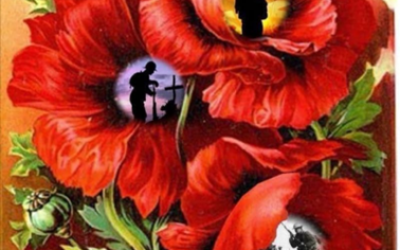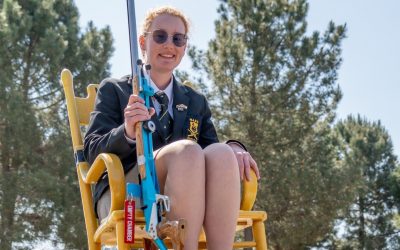In the Australian War Memorial in Canberra lies a cloth badge and some old negatives, remnants of an adventure of a group of young Australians dating back more than a century. The photographs record in eerie detail the sense of grandeur, early Australian patriotism and the hope and optimism of a generation of rifle shooters born about the time of Australia’s federation.
Australia’s military history dates to colonial days, with a unified defence force coming into existence shortly after Federation. Cadet units had existed in Australia since 1866, and compulsory military training was introduced by 1911.
The cloth badge, with the words ‘BISLEY 1911’ was received by a Junior Cadet and later NSW Rifle Association member, John Abbott Longworth. Cdt. Longworth’s family emigrated to Australia in 1849 and he was born in 1895 in Ghinni Ghinni.
The coronation of King George V was to take place in London in June 1911, and, in addition to the dignitaries and official guests, Australia was to be represented by the members of its regular defence forces. Under the leadership of Major G W Wynne, and despite lacking any official status at the Coronation proceedings, more than two hundred cadets travelled to England to attend. Major Wynne graduated from Sydney Boys High School, a school which continues the tradition of both a cadet unit and rifle club, soon after it opened in 1883.
Like many Australian teams, the Cadet Contingent had to consider how to fund their trip. A return third class fare to England would have cost up to £30, or about one fifth of the average male yearly salary. For virtually all the two hundred cadets in the Coronation Contingent, their journey to England would be their first overseas trip. Travel to England via South Africa, aboard the Themistocles, would take them six weeks.

On their way to England, the Coronation Contingent visited sites in South Africa where Australian soldiers had fought during the Boer War of 1899 to 1902. At a memorial for the Battle of Colenso, a plaque was erected from ‘the Cadets of Australia’.
Sir Arthur Conan Doyle, later author of Sherlock Holmes, and H W Wilson describe the British defeat at Colenso in terms that chillingly portray both the contemporary British view of the glory of battle (“let’s make a name for ourselves and die!”) and the shift towards modern warfare and weaponry that would play such a critical role in the stalemate of the First World War.
For fifteen-year-old Longworth and his fellow cadets, the Battles of Colenso, Magersfontein and Ladysmith belonged to a war that their parents’ generation had fought. But in terms of Australia’s military history at the time, the Boer War represented the only occasion that Australia, as a federated dominion, had participated in military conflict. The praise of Australian servicemen by Conan Doyle, and the awarding of five Victoria Crosses to Australian soldiers stand as precursors to the legend of the ANZAC that would emerge a decade and a half later.
The Cadet Contingent reached England in June 1911. For Cdt. Longworth, the visit gave him and a small group of rifle shooters in the group the opportunity to contest the fullbore rifle matches at Bisley.

The Australian cadets were warmly received in England and were inspected personally by King George V, as well as by Lord Roberts and Lord Kitchener at Bisley.

The contingent returned to Australia in late-1911. They had been away from home for six months.
Longworth continued his interest in rifle shooting, joining the NSW Rifle Association in 1912.

With the outbreak of war in 1914, the bond between the members of the Australian Cadet Contingent of 1911 would be reforged with the First Australian Imperial Force. The first contingent of 20,000 troops left Australia in September 1914 bound for Egypt. Longworth enlisted in March 1916, serving in the 34th Infantry Battalion, established at Maitland as part of the 3rd Australian Division.
Second Lieut. Longworth served under Capt. J. W. Richardson, and with Lieuts. J. C. Burges and B. G. McKenzie. Longworth, aged 22, was killed in the early morning of 12 October 1917, while rushing a machine gun emplacement near Passchendaele. The three lieutenants were mentioned in dispatches by their commanding officer for ‘conspicuous gallantry and devotion to duty’.
The 34th Infantry Battalion had been ordered to take the town but, by the end of the battle, with the infliction of huge losses to Allied soldiers, little ground had been made, and Longworth together with two of his three fellow officers and 3,196 of his fellow ANZACs lay dead.
John Abbott Longworth lies buried at Tyne Cot Cemetery at Ypres, Belgium. King George V, whilst visiting Flanders in 1922, stated that ‘the whole circuit of the earth is girdled by the graves our dead…this massed multitude of silent witnesses to the desolation of war.’

Longworth and many of his fellow cadets from the Australian Cadet Contingent of 1911, who had paraded proudly before their King at Windsor, now lay with so many of their countrymen in war graves, both marked and unmarked. It is possible to imagine that some of the cadets may have reflected upon the similarities, as they sat aboard convoy ships heading for Gallipoli or the European Front, with their earlier journey as junior or senior cadets aboard the Themistocles. Indeed, one clear parallel is the pride with which both the cadets of 1911 and the members of the Australian Imperial Force wore their uniforms and their patriotism and identification with the new Australian post-colonial culture.
Bibliography
Photographs are property of the Australian War Memorial.
Australian Red Cross Society, Wounded and Missing Enquiry Bureau Files, 1914-18 War, 1DRL/0428, < https://www.awm.gov.au/collection/C1414585> at 22 September 2021
Australian War Memorial, ‘Army Form W. 3121, Honour or Award Recommendation’, < https://www.awm.gov.au/collection/C1379325> at 22 September 2021.
Australian War Memorial, ‘Forging the Nation – Cadets at the Coronation’, <https://www.awm.gov.au/visit/exhibitions/forging/security/cadets> at 22 September 2021.
Commonwealth War Graves Commission, ‘Second Lieutenant J A Longworth’ < https://www.cwgc.org/find-records/find-war-dead/casualty-details/463645/J%20A%20LONGWORTH/> at 22 September 2021.
Doyle, Arthur Conan. The Great Boer War. McClure, Phillips., 1902.
Macintyre, Stuart. “The Succeeding Age, 1901-1942.” The Oxford History of Australia 4 (1986).
NSW Rifle Association, 1912 Annual Report, Sydney 1912.



